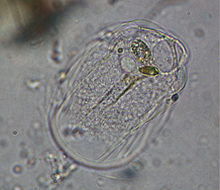Discosea
| Discosea | |
|---|---|
 |
|
| Thecamoeba striata | |
| Scientific classification | |
| Domain: | Eukaryota |
| (unranked): | Amoebozoa |
| Subphylum: | Lobosa |
| (unranked): |
Discosea Cavalier-Smith et al. 2004 |
| Subclasses and orders | |
|
|
Discosea is a class of Amoebozoa, consisting of naked amoebae with a flattened, discoid body shape. Members of the group do not produce tubular or subcylindrical pseudopodia, like amoebae of the class Tubulinea. When a discosean is in motion, a transparent layer called hyaloplasm forms at the leading edge of the cell (see lamelliopodium). In some discoseans, short "subpseudopodia" may be extended from this hyaloplasm, but the granular contents of the cell do not flow into these, as in true pseudopodia. Discosean amoebae lack hard shells, but some, like Cochliopodium and Korotnevella secrete intricate organic scales which may cover the upper (dorsal) surface of the cell. There are no species that have flagella or flagellated stages of life.
The composition of Discosea is similar to that of the class Flabellinea, proposed by Alexey Smirnov and his collaborators in 2005. However, Discosea is a more comprehensive taxon, including several groups not included in Flabellinea. In 2011, Smirnov et al. accepted Discosea as a class, and reduced Flabellinea to the rank of a subclass with the name Flabellinia.
Discosea at Ferry Siemensma's Microworld
The order Hismatismenida at Penard.com
...
Wikipedia
